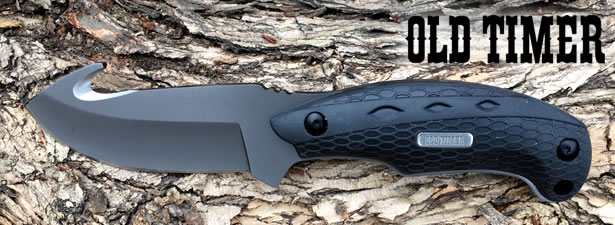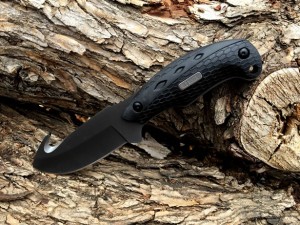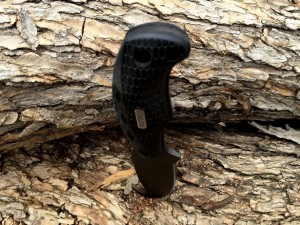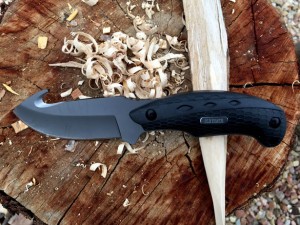Old Timer Copperhead Series 2143OT Fixed Blade Gut Hook Reviewed

Marketing from Old Timer
Let me introduce you to the Old Timer Copperhead Series 2143OT, a full tang, fixed blade knife with a handy gut hook.
Field dressing game becomes a pleasant chore thanks to the combined cutting capability of a 3.67 inch Ti-Nitride coated blade with an underside fine edge and topside gut hook—both cutting surfaces coming skinning sharp straight from Schrade.
The full tang carries the strength of the thick, high carbon 7Cr17MoV stainless blade steel the full length of the well-balanced eight inch knife where black rubber overmold snakeskin handle slabs greet your hand with a palm filling good grip… with your thumb resting comfortably on the jimped thumb ramp of the blade’s spine for excellent control and added cutting power when you need it.
A lanyard hole in the handle butt gives you the option of tethering the Copperhead to your wrist, always at the ready. The corrosion resistant combination Ti-Nitride coating and molded rubber makes the 2143OT an all-weather favorite!
Carry the fixed blade gut hook knife on your belt in its lightweight black nylon sheath. A single snap keeps the knife secure while making it a cinch to release.
Designed to serve you everyday… yet built for generations… this is the Copperhead Series 2143OT Fixed Blade Gut Hook.
Manufacturer: Schrade, taylorbrandsllc.com
Model: 2143OT
Overall Length: 8.05 inch (20.45 cm)
Blade Material: Ti-Nitride Coated 7Cr17MoV High Carbon Stainless Steel
Blade Length: 3.67 inch (9.32 cm)
Blade Thickness: 0.156 inch (3.96 mm)
Handle Material: Snake Skin TPE Rubber Handle
Handle Length: 4.40 inch (11.18 cm)
Weight: 0.44 lb. (7.04 oz)
Accessories: Nylon Belt Sheath
Warranty: Limited Lifetime Warranty against any manufacturing defects
Origin: Made in China
UPC: 044356223027
MSRP: $25.96
The Review
I have been reviewing so many bushcraft, survival and tactical knives lately, I thought it would be nice change of pace to review a hunting knife. In particular, I opted for one that was geared toward field-dressing. That is when I ran across the Old Timer Copperhead Series 2143OT, a stainless steel fixed-blade knife with a gut hook.

Initial Thoughts
The first thing that really caught my eye when I opened the box was the heavy-duty nylon sheath. I’ve never seen a one quite like it before… And I’m not really sure why. Whatever the reason, I sure do like it. It securely hold the blade in place when the strap is fastened and does not rattle whatsoever.
The 2143OT features an 8-inch full-tang blade made from 7Cr17MoV high carbon stainless steel with a an attractive titanium nitride finish, a drop-point profile, and a gut hook to aid in field-dressing. It arrived extremely sharp and ready for use. The belly of the blade is nice and wide with a long sweeping edge tailored perfectly for skinning animals.
The 2143OT’s handle consists of two snakeskin textured TPE rubber slabs with a large palm-swell and two-fingered finger groove for an excellent grip. The handle slabs are securely fastened through the tang with two recessed bolts. A lanyard hole in the handle butt is perfect for tethering the blade with paracord.
The thumb ramp jimping combined with the well-placed finger guard and two-fingered handle groove provide exceptional balance and precise three-finger control of the blade.
Features
Now let’s focus on the 2143OT’s features in more detail…
The Blade
Constructed from a single piece of 7Cr17MoV high carbon stainless steel, the 2143OT is approximately 8 inches long, 1-1/2 inches at its widest and 5/32 of an inch thick. The 2143OT’s full-tang design provide superior strength and rigidity while remaining lightweight at only 7.04 ounces. Perfect for use as a hunting blade.
 Stainless steel is a popular class of material for knife blades because it has properties that are commonly resistant to rust and corrosion, while remaining easy to maintain. In particular, 7Cr17MoV is a modified form of 440A stainless steel that contains more vanadium for increased strength, durability and wear resistance with a recommended hardness of 55/57 HRC. This makes it an excellent choice for a hunting knife.
Stainless steel is a popular class of material for knife blades because it has properties that are commonly resistant to rust and corrosion, while remaining easy to maintain. In particular, 7Cr17MoV is a modified form of 440A stainless steel that contains more vanadium for increased strength, durability and wear resistance with a recommended hardness of 55/57 HRC. This makes it an excellent choice for a hunting knife.
It is important to note that 7Cr17MoV is only rust resistant and not entirely rust proof. Even with a rugged protective coating like titanium-nitride, this alloy is still susceptible to rust and corrosion without proper care and maintenance. If the blade becomes wet, simply dry it thoroughly and lightly coat it with a protective oil like Break-Free CLP before storage. If you do, it will likely last you a lifetime.
The blade profile of the 2143OT is a drop-point with a gut hook and a deep, hollow-grind.
The drop-point pattern is one of the most popular blade patterns available today. A drop-point refers to the convex curved spine from the knife’s handle or thumb-ramp all the way down to where it meets the tip of the blade resulting in a thicker and more durable tip.
A gut hook is a specialized feature designed to aid in the field-dressing of animals. A gut hook refers to a sharpened semi-circle hook ground into the tip-end of the spine. Gut hooks are typically found on blades with a trailing-point pattern specially designed for skinning. However, it is just as effective on a drop-point blade pattern. Gut hooks can be difficult to sharpen. But with the right tools, they can be maintained like any other sharpened edge.
The 2143OT has a deep, hollow-grind and a slight compound bevel without any serrations. The grind refers to the taper from the spine or cheek of the blade to the blade’s edge. With a hollow-grind, the taper is typically ground using a wheel between 10 and 14 inches in diameter. The result is a concave-shape in each side of the blade that yields a very sharp edge. This is a very common grind on factory knives these days and it is relatively easy sharpen and maintain.
The sharp 90 degree spine work perfectly when striking a ferro rod, with or without the protective coating. However, as you strike the ferro rod the protective coating will quickly wear off.
The Handle
The 2143OT’s handle consists of two durable TPE rubberized handle slabs with an attractive snakeskin textured pattern providing an excellent non-slip grip even in the wettest of conditions. Thermoplastic Polyester Elastomer (TPE), sometimes referred to as thermoplastic rubber is made from a mix of plastic and rubber polymers providing both thermoplastic and elastomeric properties.
 The two halves are attached through the full-tang blade with two recessed Torx screws threaded directly into the knife steel for superior shock absorption, thereby reducing fatigue. The handle features a large palm-swell, a two-fingered groove and a raised bolster making it easier to hold on to with or without gloves.
The two halves are attached through the full-tang blade with two recessed Torx screws threaded directly into the knife steel for superior shock absorption, thereby reducing fatigue. The handle features a large palm-swell, a two-fingered groove and a raised bolster making it easier to hold on to with or without gloves.
Jimping is a term commonly used to describe the small notches cut into the 2143OT’s thumb ramp located at the top of handle to prevent slippage while performing a thrusting motion as well as delicate skinning and bushcraft tasks.
The 2143OT has a finger guard that provides positive protection against blade slippage and injury without being too large and getting in the way. The thumb ramp jimping combined with the well-placed finger guard and two-fingered handle groove provide exceptional balance and precise three-finger control of the blade. Perfect for field-dressing and skinning game.
The 2143OT has a moderate-sized lanyard hole located at the rear-bolster capable of holding a paracord lanyard.
The Sheath
The 2143OT comes with a heavy-duty black nylon sheath that is lined and riveted for exceptional durability. Its simple design is both attractive and functional, securely holding the blade in place with single-button strap that is very easy to operate. No noticeable movement or rattling of the blade whatsoever. The attached belt loop is capable of supporting a 2.25-inch belt.

Functional Testing
What can the 2143OT do? In order to provide a some sort of apples-to-apples comparison between blades, I will be performing six durability and performance tests; Batoning, Chopping, Feathering A Stick, Tip Strength, Gut Hook Edge and Edge Retention. In a survival situation, all resources are fair game. However, since I am not in a life-or-death situation, I’ll stick to some dead wood that I have lying around for these tests.
Batoning
Batoning is likely something that you would never do with a skinner, much less a blade with a gut hook. However, I find that batoning a good way to quickly demonstrate the strength and durability of the blade material and its ability to hold an edge under extreme conditions.
To test the 2143OT at batoning, I decided to quarter a few of 3-inch logs about 12-inches in length and then I further processed a few of the pieces into smaller kindling. Starting with anything larger would have likely been a futile exercise with such a short blade. I used the baton to strike the spine of the 2143OT near the tip, just beyond the hook so I wouldn’t risk damaging it.
I was able to quarter the material without any difficulty whatsoever. The blade sliced through the grain with ease and as the material got smaller, it became easier and easier to work. Before I knew it, I had about 30 or so pieces of small kindling. The aggressive hollow-ground profile split through the grain cleanly and without much effort.
Chopping
Chopping is yet another task that you would likely never consider with a blade designed for processing animals unless it was an emergency. However, I feel it is the best way to determine just how tough a blade really is… Only I’m doing it for you so you don’t have to. Will the edge of the 2143OT chip or roll? Lets find out.
The 2143OT doesn’t really have any of the characteristics of a good chopper. It is short in stature, very lightweight and it is not recurved so the belly of the blade is better-suited for slicing and skinning. However, the handle is very comfortable to hold, even toward the end which provides some additional leverage and power behind your swing.
 With each swing the blade does bite into the material you are chopping. However, due to its blade shape only a small amount of material is cut with each strike. As a result, it is a very slow process to get all the way through even the smallest logs with such a short blade. You are definitely better off if you can have a hand axe or hatchet with you as well. However, if it is all you’ve got, just go for the smaller material instead.
With each swing the blade does bite into the material you are chopping. However, due to its blade shape only a small amount of material is cut with each strike. As a result, it is a very slow process to get all the way through even the smallest logs with such a short blade. You are definitely better off if you can have a hand axe or hatchet with you as well. However, if it is all you’ve got, just go for the smaller material instead.
Feathering A Stick
Typically, I prefer a recurved blade for performing tasks like feathering a stick. However, the 2143OT’s jimped thumb ramp and two-fingered handle groove provide so much fine control over the blade, I felt this test would likely go exceptionally well.
To test the 2143OT at feathering a stick, I chose a stick about 1-inches in diameter and around 12-inches in length. I began by taking long 5-6 inch strokes around the bottom-end of the stick, shaving off fine curls otherwise known as “feathers” with each pass. Before I knew it, I had a pile of thinly-cut wood shavings ready to start a fire.
Tip Strength
Testing the 2143OT’s ability to stab or pierce without bending or breaking the tip, I drove the blade into the end of a 12-inch stump with a baton about an inch deep. Then I loosened the blade using a side-to-side motion until it became loose enough to pull out. I repeated this action a few more times without any sign of chipping or tip damage.
The final test was to bore a hole into the side of a log. By twisting the 2143OT back and forth, I was able to bore the hole approximately 1.25-inches in diameter and about 1-inch deep. The stout point performed very well on this task with no sign of wear or damage.
Gut Hook Edge
To test the slicing ability of the gut hook without any wild game readily available, I chose to fold a sheet of 20-pound stock three times and then pull the gut hook through the material three times. It sliced cleanly through without any resistance. Next, I decided to perform the same test on a piece of leather approximately 1/8-inch thick. Again, the gut hook sliced cleanly through the material without any resistance.
Edge Retention
After all of the other functional testing had completed, the 2143OT was able to slice cleanly through the same single sheet of paper as it had before. Performing the tests left no sign of cracks, chips or imperfections of any kind with the exception of some slight wear on the blade’s protective coating. The 2143OT held its edge and remained very sharp through the entire process.
Final Thoughts
The Old Timer Copperhead Series 2143OT is a rugged hunting knife with all of the characteristics of a great skinner and field-dresser. It is compact, lightweight, very ergonomic, and most of all it was built tough enough to last a lifetime. The reinforced nylon sheath that it comes with is well-fitted and it provides excellent blade protection and retention.
As a hunting knife, I have been thoroughly impressed with the 2143OT. With its unique handle design, jimped thumb ramp and two-fingered handle groove, the 2143OT is easily one of the most comfortable and controllable blades that I’ve had the pleasure of using in some time. It is hard to believe just how incredibly affordable it really is… You really get a lot of bang for your buck with this one. I happily give it two thumbs up.
You can find this and other Old Timer knives here: http://amzn.to/2bYtQ4d
![]()
About Taylor Brands and Old Timer
 Founded by Stewart Taylor in 1975, Taylor Brands has been manufacturing, designing, and distributing high-quality stainless steel cutting tools and accessories since our inception. Taylor Brands owns and produces Schrade, Old Timer, Uncle Henry, and Imperial branded products, and are also licensed to produce multiple product lines under the world famous Smith & Wesson brand. In total Taylor Brands manufactures several hundred different products including fixed and folding knives, collapsible batons, tactical pens, handcuffs, tactical and survival accessories, and flashlights.
Founded by Stewart Taylor in 1975, Taylor Brands has been manufacturing, designing, and distributing high-quality stainless steel cutting tools and accessories since our inception. Taylor Brands owns and produces Schrade, Old Timer, Uncle Henry, and Imperial branded products, and are also licensed to produce multiple product lines under the world famous Smith & Wesson brand. In total Taylor Brands manufactures several hundred different products including fixed and folding knives, collapsible batons, tactical pens, handcuffs, tactical and survival accessories, and flashlights.
--